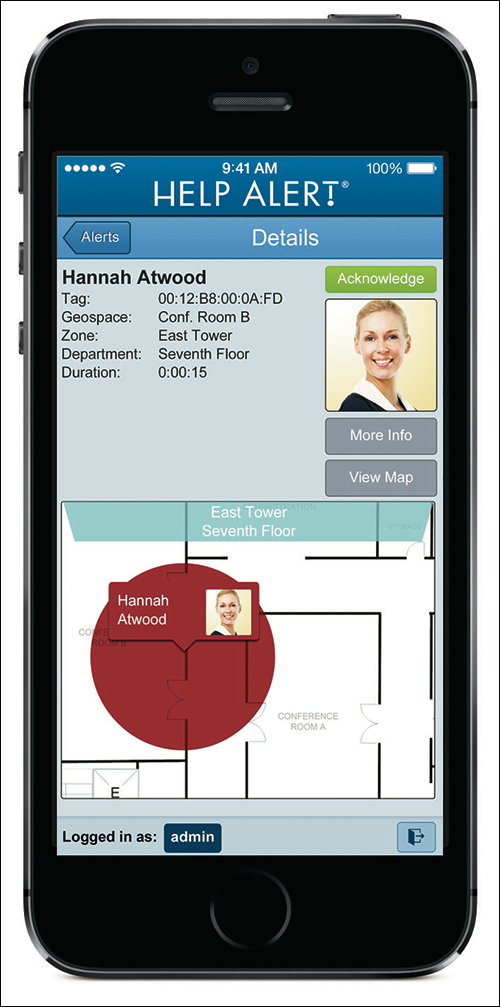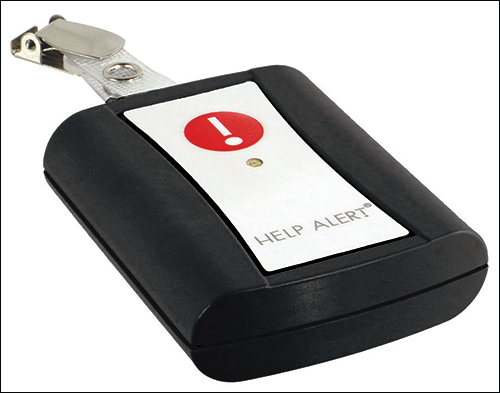During the past two years, at least 45 New York City hotels have installed a real-time location system (RTLS) solution from RF Technologies, known as HelpAlert, to ensure that they can respond to an emergency if a staff member requires help. The system addresses demands raised in 2013 by the New York Hotel and Motel Trades Council (the union of hotel workers in the New York City metropolitan area and in New York State’s capital region). All of the installations took place after members of the Hotel Association of New York City, which represents 160 of New York’s approximately 450 hotel properties, accepted those requirements.
HelpAlert, which features Wi-Fi-based active RFID tags for tracking personnel and assets, employs software known as PinPoint to closely identify a tag’s whereabouts, based on the location of the Wi-Fi access points that receive the tags’ transmissions, as well as on signals received form Wi-Fi-based tags installed as reference points. RF Technologies, which has offered PinPoint (as well as HelpAlert) for the past several years, released its latest version, PinPoint 2.2, last month. The new software supports location-based video display technology that can be integrated with a user’s IP cameras or video-management system. With PinPoint 2.2, a user can not only receive an alert indicating the ID number and location of an employee who issues a call for help via a PinPoint RFID pendant, but also view video from the four cameras closest to that individual.
The solution also comes with RF Technologies’ HelpAlert app for iOS devices, enabling users of Apple iPhones or iPads to receive alerts triggered when an individual presses his or her pendant’s HelpAlert tag alarm button.
In 2011, a hotel employee accused International Monetary Fund (IMF) director Dominique Strauss-Khan of sexually assaulting her in her room, and a similar incident occurred several weeks later at Pierre Hotel, also in New York, involving a housekeeper and an Egyptian banker, leading to an arrest. Within the next year, the New York Hotel and Motel Trades Council was negotiating a seven-year contract with the Hotel Association of New York City. The contract stipulated that hotels install an alerting system to keep personnel safe in occupied hotel rooms.
The hotels then approached vendors seeking solutions. To date, approximately 90 have an RTLS solution in place, about half of which are using the PinPoint solution. Several of the hotels’ requirements had made PinPoint a good option, says Kurt Knipper, RF Technologies’ business development manager. Most of the midsize or smaller hotels lacked an IT department, and thus needed a system that would be easy to implement, and that would not require the properties to break into walls to run power or Ethernet cables.
Typically, Knipper says, what they did have, or were seeking, was a robust Wi-Fi network for their guests, and that made a Wi-Fi-based emergency-response solution a good idea. To provide greater location granularity—for example, identifying a pendant’s location specific to a room or a bank of about three rooms—RF Technologies also provides battery-powered reference tags, each of which transmits its own unique ID. If a hotel employee uses a PinPoint pendant to summon help, that individual’s pendant receives the IDs of any reference tags IDs within its vicinity, and then transmits those IDs, along with its own.
The pendant is typically attached to the universal key that a worker uses to open guest rooms. Hotels have opted for one of two possible models for pendant management. The first option is to assign a pendant to each employee, with the pendant and universal key attached to that individual’s key ring, and the pendant ID’s number linked to his or her name and picture in the PinPoint software residing on the hotel’s back-end server. In that way, if a worker presses the pendant’s button in order to call for help, authorized hotel personnel will receive the alerts via e-mail or text message. PinPoint software running on their computers will then indicate that an emergency is underway, and will display the location, name and picture of the individual assigned to that pendant.
In a second option, a key and pendant are attached to a key ring that an individual picks up upon reporting to work, and there is thus no specific association between that person and the pendant’s ID. With that option, if a worker presses the pendant’s button, authorized staff members would receive an alert displaying only the employee’s location, but not his or her name or photograph.
When a pendant’s button is pressed, a small red LED on the device is illuminated. An e-mail or text message is sent to the phones of security guards or other personnel, while any PCs running PinPoint software on office computers will display the alert as well. Any individuals viewing the alert on the software can then press a prompt to acknowledge receipt, and that status is forwarded via a Wi-Fi connection to the pendant, which changes its light from red to green, thereby discretely letting the individual in distress know that help is on the way.

With the latest version of PinPoint, the hotels have an additional tool. Once a pendant’s button is pressed, a hotel can use the PinPoint software to view video footage from the four closest cameras, in order to help identify what is happening at that location. Some hotels are now installing RF Technologies’ asset tags or pendants to take advantage of this function. For instance, if there is a problem at the front desk, four cameras are likely to be recording video in that area, and the collected data can be very useful to security. A pendant could be attached under a desk, or on a wall near an elevator, providing workers with other options for summoning help.
With the app, users can view the name and photo of the worker who has pressed the alert pendant tag button (provided that the hotel is using the system in that way), and can also see where that individual is located. Furthermore, the app’s users can select a prompt indicating that they are responding to the call. Assuming that the hotel had integrated the PinPoint 2.2 software with its video cameras, they would also be able to view any real-time camera images.
The Kitano New York, a hotel located in midtown Manhattan, launched the system three weeks ago to provide the necessary security for staff members as they work throughout the building. As many as 30 workers are attaching the HelpAlert pendant tags to their belts or aprons, according to Ken Kilimet, Kitano’s director of security. When a staff member begins a shift, the security department manually records that worker’s name, along with his or her pendant ID number, but the software does not keep track of who has each pendant. The important detail for the security department, Kilimet explains, is knowing that an employee has pressed a pendant alert button, and where that happened. Once the button is pressed, he says, he can track that worker’s location and movements. The Kitano New York is not using the technology with camera integration.
While the housekeeping staff all wear the pendants, Kilimet notes, he is also encouraging every desk staff and sales member to carry one when alone with guests—for instance, when showing them a room. “Nobody’s needed it yet,” he says, indicating that there have not been any incidents either before or after the system’s installation. “It’s good for us though,” he says, since it provides an added level of security in the event that an incident does occur.



